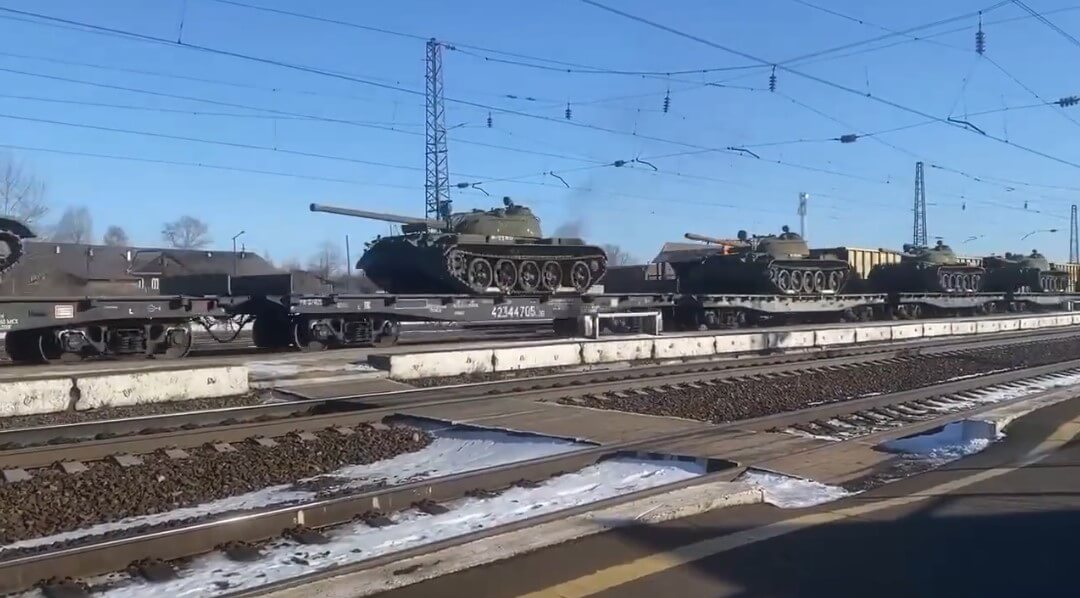Numerous photos and videos confirm that the Russian Armed Forces are moving T-54 medium tanks on their rail network. Their final destination seems to be Ukraine, but their usefulness there will be limited and they will be very vulnerable to Ukrainian battle tanks, delivered battle tanks or modern anti-tank systems. The longer the conflict in Ukraine drags on, the more the Russian Land Forces seem to pull out older and older vehicles from their stocks.
Tanks on a train
The Russian Armed Forces are known to hold a fairly large number of military vehicles stored throughout Russia. This is an advantage for the Russian military as they can fill in a large number of lost vehicles with these various stockpiles... at least in theory! Photos and videos published this March 22 (excerpt below) confirm that a military train in Russia carries T-54 medium tanks. This tank is the direct successor of the Soviet T-34 medium tank, and this, since the late 1940s. It should be noted, however, that the two models identified date from the 1950s;
- T-54-3; production between 1952 and 1955, redesigned turret, telescopic sight TSh-2-22, smoke generator TDA, better protection of bearings and electrical devices against dust.
- T-54B; production between 1957 and 1959, change of gun (100 mm D-10T2S rifled barrel) with the addition of a Cyclone stabilizer (hit-to-kill probability increases from 30% to 60%), addition of a self-sealing system for fuel tanks. In 1959, the last T-54Bs leave the factories with an infrared projector, an infrared sight TPN-1-22-11 and an infrared projector for the commander of the tank.
Notwithstanding, the Russian Armed Forces seem to mobilize several tanks whose age varies between 71 and 64 years. For aviation fans and unaccustomed to ground equipment, this announcement would be equivalent to the Russian Air Force re-commissioning MiG-15 fighters or M.D. 450 Hurricanes by the French Air and Space Force!
Too many casualties in Ukraine
Lack of tanks
Their destination is not confirmed at this time. However, one hypothesis seems to be coming back within many OSINT specialized sources; Ukraine! Since February 24, 2022, the Russian Armed Forces have lost nearly 1,871 tanks (according to Oryx). Therefore, the deployed military has a great need for new tanks. However, modern battle tanks cannot be released at a fast pace, so the Russian military industry is limited to 20 modern tanks per month. Russia then draws on its stocks, but these tanks must first go through a factory to be overhauled and perhaps re-equipped with certain equipment (newer but not especially modern radios and sensors). This adds up to a maximum of 90 tanks/month, for a total of 110 tanks/month... versus an average of 150 losses every month! (from The Economist)
Limited usefulness
If this assumption is true, their usefulness will be limited; the T-54 is still, of course, an armored, all-terrain vehicle with a 100mm gun. It can therefore be used to support infantry or armor. On the other hand, this tank is totally outdated for anti-tank combat, at least against modern battle tanks. The Iraqis demonstrated their ineffectiveness against modern and recent battle tanks during operations Desert Storm (1991) and during the invasion of Iraq in 2003. Thus, with the exception of the older Ukrainian tanks, these tanks will be a piece of cake for the modernized Ukrainian T-64, T-72 and T-80, not to mention the Leopard 2, Challenger 2 or even Abrams being delivered.
In addition, the gun stabilization systems are not effective and the Soviet tankers preferred to shoot at a standstill and at a distance of about 1 kilometer from their target. The protection of the crew will also be catastrophic: during the Vietnam War, the T-54 and T-55 (improvement of the T-54) prove to be very vulnerable to the M72 LAW rocket launchers and BGM-71 TOW anti-tank missiles. There is no need to describe the effectiveness of the improved versions of LAW and TOW, not to mention the newer anti-tank systems (FGM-148 Javelin) on such tanks in view of their effectiveness against the much more modern Russian T-72B3, T-80BVM and T-90.
Finally, one must also think about the logistics of this eventual re-commissioning; these tanks are several generations behind and thus any spare parts can only come from other T-54 tanks cannibalized to keep the other deployed T-54s in "combat condition." From then on, their arrival will be a logistical headache.
Just the chassis?
Another hypothesis would be to remove the turrets from the tanks in order to use the chassis for secondary tasks; breakdowns of various damaged vehicles, bridge launchers, all-terrain cranes, etc. This assumption is less likely, however, as the urgency for the Russian military seems to be more focused on tanks and not on holding support vehicles.
And many more!"
This is not the first time that Russia has brought out vehicles dating back to the early Cold War. In February, BT-50 armor, produced between 1954 and 1970, was spotted on tank carriers in Ukraine (article on the subject). The specialized OSINT site has just released a article about the oldest vehicles used by Russian Forces in Ukraine. It is already possible to confirm the presence of BRDM-2 armored fighting vehicles (from 1962), D-1 towed artillery piece (from 1943) or even DhSK naval machine guns (from 1938) attached to MT-LB armor (tweet below).
It should also be noted that the qualification of main battle tank (MBT) does not apply for the T-54 because the latter does not meet the characteristics of the MBT and is moreover thought in a doctrine including light, medium and heavy tanks (even super-heavy).
Découvrez cet article sur Air&Cosmos

